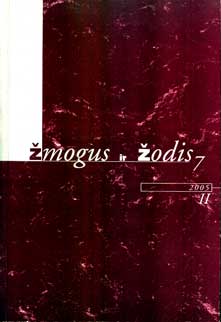Du Henry Parlando miestai
The Two Cities of Henry Parland
Author(s): Sanna NyqvistSubject(s): Literary Texts
Published by: Vytauto Didžiojo Universitetas
Keywords: urban writer; modernism; expressionism; formal izm; irony; metafiction.
Summary/Abstract: In 1929 the Finland-Swedish writer Henry Parland (b. 1908 in Viipuri, Russia, d. 1930 in Kaunas, Lithuania) was forced to leave Helsinki for private reasons and installed himself in Kaunas, Lithuania, where his uncle Wilhelm Sesemann worked as a professor of philosophy. In Lithuania the bohemian Parland devoted himself to studies and to writing: the one and half years before his death in measles turned out to be the most prolific in his life. In Kaunas he could get in contact with the most recent European aesthetic currents -expressionism, early Russian cinema, formalist theory - which inspired him to write perhaps the most international texts of Finnish modernism. Parland was essentially an urban writer - many of his short stories and his only novel Sonder (Broken) are set in a modern city recognisable as Helsinki, or metropolitan atmosphere Parland experienced through films. Parland was not primarily concerned with realistic setting - in an article fragment he described Kaunas, at the time a little provincial town, as a bustling city where shopping centres and skyscrapers are being built. In his works the city rather mirrors its inhabitants, the modern rootless flaneurs, whose lives Parland described with psychological and sociological accuracy suffused with irresistible irony. The metafictional and semi-autobiographical novel Sonder remains one of the greatest explorations of the modem city and mind in European literature.
Journal: Žmogus ir žodis
- Issue Year: 07/2005
- Issue No: 2
- Page Range: 62-66
- Page Count: 5
- Language: Lithuanian

